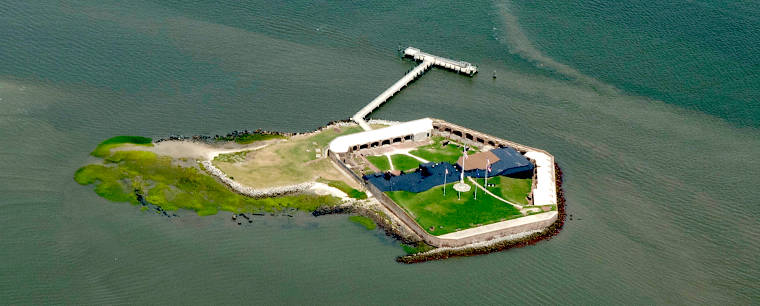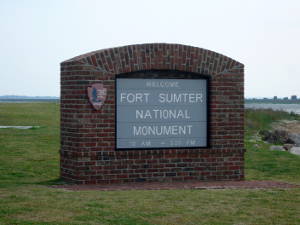Fort Sumter National Monument

Fort Sumter

Fort Sumter is where the opening shots of the Civil War were fired. The fort is built on an island in the heart of the shipping channel leading to Charleston. The fort was planned after the conclusion of the War of 1812 but construction didn't begin until 1829. When South Carolina fired the first cannons of the Civil War on January 9, 1861, it was to repulse a contingent of Union supply ships trying to reach the garrison at Fort Sumter with supplies and reinforcements. South Carolina had already seceded from the Union but construction on the Union-held fort wasn't yet finished. A month before, Union Army Major Robert Anderson had abandoned nearby Fort Moultrie and moved his men, cannons and supplies to Fort Sumter. Fort Moultrie was indefensible and Fort Sumter was handicapped by the lack of cannons that had been dropped from the construction because of military downsizing ordered by President Buchanan.
On Friday, April 12, 1861, the Confederate cannons began firing at Fort Sumter around 4:30 am. They kept firing at the fort for 34 hours straight. The Union troops were further handicapped by having no fuses for their explosive cannon shells and could only use solid iron balls. They also had precious few of those so Union fire was slow and sporadic at best. On both sides the only mortalities were inflicted by their own misfiring cannons. On Saturday afternoon the Union garrison ran up a white flag and surrendered. A Union supply ship sitting just offshore was allowed to take on the Union garrison and sail out of the harbor, taking Anderson and his men to New York.
Confederate occupation of the fort wasn't challenged until September 8, 1863, when Union forces attempted to retake the position. Poor intel and an extreme lack of cooperation between Army and Navy commanders caused the failure of the mission. The Navy bombardment did succeed in reducing the structures to rubble but the island remained in Confederate hands until it was evacuated in advance of General Sherman's troops burning and trashing their way through South Carolina in February, 1865.
When the war was over, Fort Sumter had been reduced to ruins, all the usable hardware having been evacuated by the Confederates in advance of Sherman's troops. The Army worked to restore some usefulness to the fort but from 1876 to 1897 the property served primarily as an unmanned lighthouse station. Interest (and reconstruction) perked up during the Spanish-American War but the fort never saw action again.
Today's Fort Sumter National Monument encompasses three sites in its 235 acres: Fort Sumter, the Fort Sumter Visitor Education Center in Charleston, and Fort Moultrie on nearby Sullivan's Island. Access to Fort Sumter itself is available only via boat, most folks taking the 30-minute ferry ride from the Visitor Education Center dock.
The Fort Sumter Visitor Education Center on Liberty Square (340 Concord Street) in Charleston is open daily, 8:30 am to 5 pm, except for Thanksgiving, Christmas and New Years Days. The Fort Moultrie Unit (1214 Middle Street in Sullivan's Island) is open daily, 9 am to 5 pm, except for Thanksgiving, Christmas and New Years Days. Park Headquarters is located next to the Fort Moultrie Visitor Center and is open Monday through Friday, 7:30 am to 4 pm, except for Federal holidays.
There is no entrance fee for Fort Sumter but the island can only be reached via private ferry. It's highly recommended that visitors purchase ferry tickets prior to the day of their visit. Concessionaire: Fort Sumter Tours. There is a nominal fee for visiting Fort Moultrie.
Upper left photo courtesy of Wikipedia userid Staib, CCA-by-SA 3.0 License